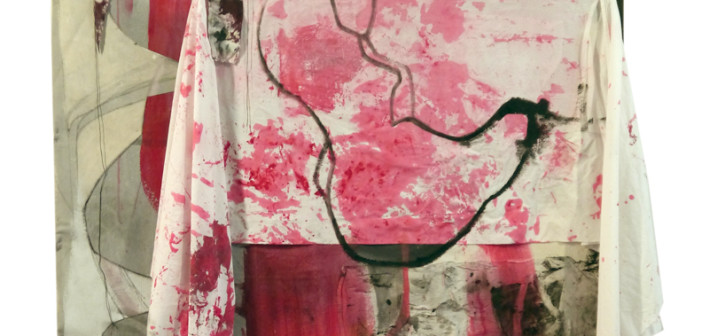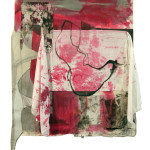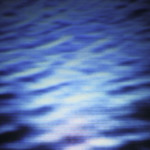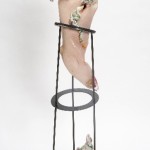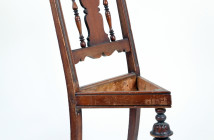The Art Institute of Boston's low residency graduate program culminates this year in two group shows (one on each campus) featuring 15 artists. As a low residency program, it attracts established artists who have both life and studio experience, but have reached an impasse where they wish to push their work in new directions. The work here is not obviously "student" work, but is quite polished, and represents a wide-open field of media and concepts, directly relevant to current art world and cultural concerns. Comprised of painting, video, drawing, sculpture, projection, ceramics and more, each artist presents a fully realized statement. As such, the shows don't present overarching themes, though there are affinities.
In Cambridge, Kathline Carr's large abstractions are stitched together from a variety of fabrics, sewn and glued and painted (sometimes with needle and thread still present), in order to create visceral, gestural combines in the abstract expressionist or neo-dada modes. Her accumulations use blankets, sheets and drapes, and as such are related to Rauschenberg's Bed (1955), with new stories to tell.Argument at Tactile Center doesn't feature a body, but the red stains and scalloped cutouts suggest violent wounds. Gilgo Beach Blanket suggests a network of connections waiting to be found at a site where female serial killer victims were buried.
Political messages are found in the work of Sarah Barr and Jason Pramas. Barr's mysterious video (which photographs an archival Xerox machine producing faded images from microfilm) indirectly references her loss of faith, as the images being researched document a papal visit where patriarchal allegiances were clearly valued over interactions with women. Pramas, with deadpan delivery and dry captions, explores a buried history in Peabody - The Syntropy Archive. He exposes the city's hidden past as a unionized leather district, including contentious Communist leadership and the systematic dismantling of such influences dating from the McCarthy era. His simple scenes of modern Peabody edifices become ironic commentary on struggles and alternative politics that were long ago repressed. But he also notes that the leather industry was a harsh one, not really missed by anyone. Nowhere is this ambivalence more clear than in his frontal shot of pedestal in a city park, a place-holder for a commemorative statue that was never made.
In Boston, Rita Maas's expressionistic, abstract video takes a far different approach. Donning headphones, one hears a soundtrack of bird sounds and rippling water, which relates loosely to the projection of colors rippling across a fluid river surface. Her photographs are re-photographed projections of videos taken at several sites, and her soundtrack also has been re-recorded several times. The effect of the media intervention both obscures the source material and reduces it to an abstract essence.
Sensuality is also evoked by Nicole Daviau's Between/Within, a womb-like box of stretched skin-like white material with a glowing core at its center. Large enough to enter, this quasi-organic environment squishes under bare feet and invites contemplations, discussion and exploration. In a way, Michelle Saffran's large-scale photo-collages have a similar contemplative side; her colors are monotone, her panels of imagery carefully but not symmetrically sewn together. Figures and shapes repeat or mirror each other, creating a kind of ghostly sensation and mournful tone. Whether it's a memory fading away or coming back to prominence in the mind is up to each viewer.
Of the ceramics, few works could be more different than Jessica Putnam-Phillips' decorative platters and Linda S. Fitz Gibbon's somewhat vase-like sculptural forms. Putnam-Phillips decorates her platters with unexpected imagery: contemporary female soldiers in uniform. The patterns and colors aren't out of place on china; but the imagery is unusual, meant as a surprise reveal should the plates ever be used. Putnam-Phillips brings her own experience as a former soldier (she served in Desert Storm) to realistic accuracy regarding attire and weaponry. The resulting works are meticulous yet upbeat, a window into the evolving world of women in the military. The pun of "server" and military service is intentional, playing with expectations of duty and domesticity.
Fitz Gibbon's shapes are, by contrast, playful, abstract and weird. Her pottery skills are evident in the carefully drooping, folded, sagging and bulbous shapes, but most of all in her lush glazes of green, pink and turquoise. However, she's more interested in twisting and transforming her works so that they offer unusual surprises. Whether hanging pendulous from the ceiling or flopping over hooks and shelves, these oddly swelling sacks use Astro-turf, piano wire and mirrors to create hidden areas of incident and unusual bursts of texture and shape. They're somewhere between flora and fauna, alien creations giving birth to themselves.
With the end of Big Red & Shiny’s first academic year quickly approaching, we’ve been taking stock of the past 8 months to identify our successes and re-evaluate where we’d like to have a larger impact. One part of our mission has always been to highlight new voices within our cities—emerging artists who are bringing exciting ideas and techniques to their mediums or those who may just be graduating into our arts scene. Around this time every year we are provided with some of these best new voices and, given the number of academic institutions in our area, we have quite a bit to choose from. It only seems fitting then that we take the time to recognize the important work coming out of our schools. We will, of course, only be able to represent a small sampling of those institutions, but over the next few weeks we hope to provide a snapshot of promising, soon-to-be matriculated Boston artists.
- Kathline Carr, Argument at Tactile Center
- Jason Pramas, Peabody – The Syntropy Archive
- Rita Maas, from the series Tidal Volumes of the Hudson River
- Jessica Putnam-Phillips, Convoy
- Linda Fitz Gibbon, Slither

